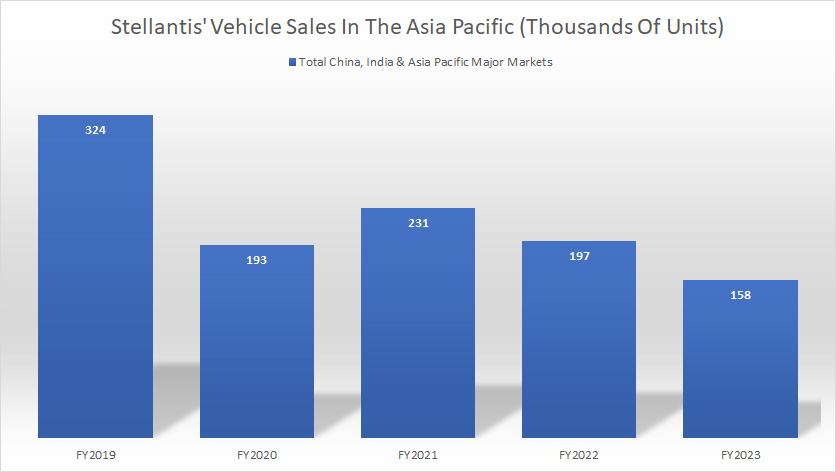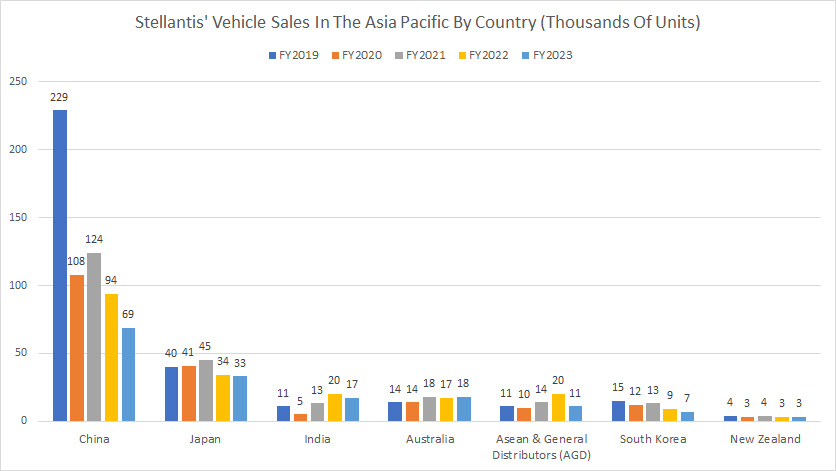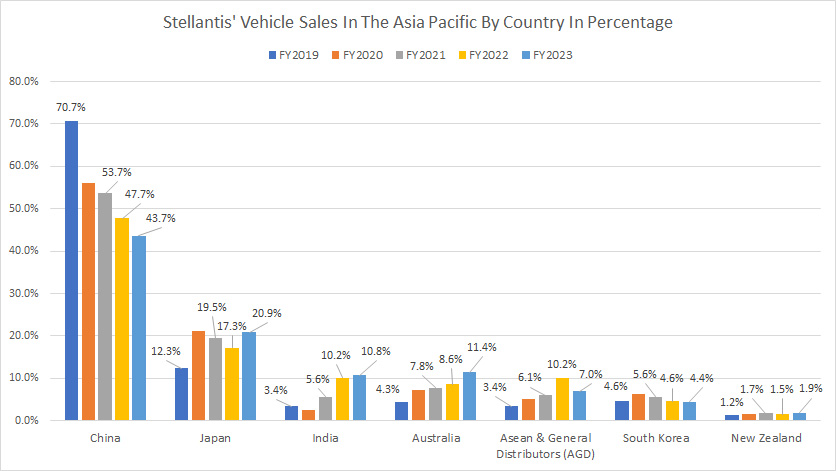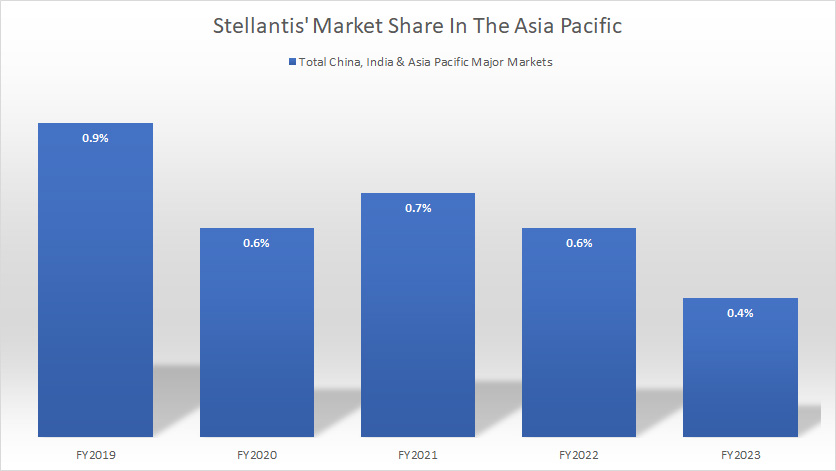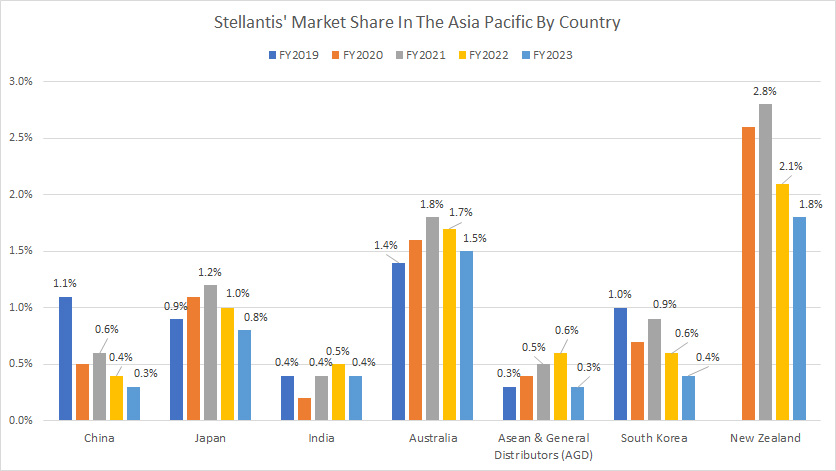
Maserati car. Pixabay image.
Stellantis, a leading global automotive group, has been making significant strides in expanding its presence in the Asia Pacific region. With a history of over a century, Stellantis has an impressive portfolio of iconic automotive brands, including Peugeot, Citroen, Fiat, Chrysler, Jeep, and Alfa Romeo.
The company has been actively working to establish a strong foothold in Asian markets, leveraging its extensive experience and expertise in the automotive industry to offer innovative and sustainable mobility solutions to customers across the region.
This article presents Stellantis’ vehicle sales in China, India, and other countries in the Asia Pacific region, as well as its competitive position in this region.
Investors interested in Stellantis’ vehicle sales and market share in North America, South America, Europe, and the MEA region may find more information on these pages: Stellantis North America, Stellantis South America, Stellantis Europe, and Middle East & Africa.
Let’s get started!
Please use the table of contents to navigate this page.
Table Of Contents
Definitions And Overview
O2. How Stellantis Expands Its Presence In The Asia Pacific
O3. How Stellantis Distributes Its Vehicles In The Asia Pacific
O4. How Stellantis Provides Financing To Dealers And Customers In The Asia Pacific
Consolidated Sales
A1. Vehicle Sales In Major Markets In The Asia Pacific
Sales By Country
B1. Vehicle Sales In China, Japan, India, Australia, And Other Asian Countries
B2. Vehicle Sales In China, Japan, India, Australia, And Other Asian Countries In Percentage
Consolidated Market Share
C1. Market Share In Major Markets In The Asia Pacific
Market Share By Country
D1. Market Share In China, Japan, India, Australia, And Other Asian Countries
Conclusion And Reference
S1. Conclusion
S2. References and Credits
S3. Disclosure
Definitions
To help readers understand the content better, the following terms and glossaries have been provided.
New Vehicle Sales: Stellentis defines its new vehicle sales as the sales of vehicles primarily by dealers and distributors or, directly by the company in some cases, to retail customers and fleet customers.
Sales include mass-market and luxury vehicles manufactured at Stellantis’ plants, manufactured by joint ventures and third-party contract manufacturers, and distributed under its brands. Sales figures exclude sales of vehicles that it contracts to manufacture for other OEMs.
While vehicle sales are illustrative of Stellantis’s competitive position and the demand for its vehicles, sales are not directly correlated to net revenues, cost of revenues, or other measures of financial performance in any given period.
For a discussion of Stellantis’ vehicle shipments that directly correlate to its Net revenues, Cost Of revenues, and other financial measures, you may visit this article: Stellantis Vehicle Wholesale.
Asean & General Distributors (AGD): AGD includes Bangladesh, Brunei, Cambodia, French Polynesia, Indonesia, Laos, Malaysia, Myanmar, Nepal, New Caledonia, Philippines, Singapore, Sri Lanka, Thailand, and Vietnam.
How Stellantis Expands Its Presence In The Asia Pacific
Stellantis sells a variety of vehicles in the China and India & Asia Pacific segment, including small and compact cars, premium mid-size cars, utility vehicles, and light commercial vehicles. Although it is the smallest segment in terms of vehicle sales, the China and India & Asia Pacific segment represents a significant growth opportunity for the company.
Stellantis is committed to building strong relationships with key partners in India to increase its manufacturing footprint and regional presence. In November 2023, Stellantis invested €1.4 billion in Zhejiang Leapmotor Technology Co. Ltd, a Chinese new energy vehicle OEM, gaining approximately 21% equity in the company. This investment is accounted for as an equity method investment and reported in the China and India & Asia Pacific segment.
Additionally, Stellantis will create a joint venture called Leapmotor International in 2024, with ownership of 51% by Stellantis and 49% by Leapmotor. Stellantis will control the joint venture and consolidate the entity. The joint venture will have exclusive rights for export, sale, and manufacturing of Leapmotor products outside Greater China. The joint venture is expected to begin shipments in the second half of 2024.
Apart from manufacturing its vehicles, Stellantis also distributes vehicles manufactured in the U.S. and Europe through its dealers and distributors in the China and India & Asia Pacific segment.
How Stellantis Distributes Its Vehicles In The Asia Pacific
Stellantis distributes its vehicles in the Asia Pacific region through different channels depending on the market. In key markets such as China, Australia, India, Japan, South Korea, and AGD, Stellantis vehicles are sold through 100% owned subsidiaries or agreements with local independent dealers.
For example, the Dongfeng Peugeot Citroën Automobile Sales Co (DPCS) markets the vehicles Stellantis produces in China. At the same time, a fully-owned national sales company operates and manages the import vehicles’ sales (except Maserati).
In smaller markets, Stellantis has agreements with general distributors.
How Stellantis Provides Financing To Dealers And Customers In The Asia Pacific
Stellantis provides financing to customers and dealers in the Asia Pacific region through its wholly-owned finance and lease companies, Stellantis Automotive Finance Co., Ltd, and Stellantis Leasing Services Co. Ltd. These entities offer a wide range of financing and leasing products to support sales activities in China.
Cooperation agreements with third-party financial institutions enable Stellantis to provide dealer network and retail customer financing in India, South Korea, Australia, and Japan. This allows the company to offer its dealer networks and retail and commercial customers a full range of wholesale and retail financing options to suit their needs.
Vehicle Sales In Major Markets In The Asia Pacific
Stellantis-vehicle-sales-Asia-Pacific
(click image to expand)
A definition of Stellantis’ vehicle sales is available here: vehicle sales. Stellantis’ total vehicle sales in the Asia Pacific declined to 158,000 vehicles in fiscal 2023 from 197,000 vehicles in 2022, down 20% year-over-year.
Stellantis has consistently sold fewer vehicles in the Asia Pacific since 2021, with vehicle sales reaching their lowest level as of 2023, demonstrating the company’s declining competitive position in this region.
Vehicle Sales In China, Japan, India, Australia, And Other Asian Countries
Stellantis-vehicle-sales-Asia-Pacific-by-country
(click image to expand)
The definitions of Stellantis’ vehicle sales is available here: vehicle sales. AGD’s definition is available here: AGD.
China is Stellantis’ biggest market in the Asia Pacific, with vehicle sales reaching 69,000 units in fiscal 2023 in this country. Although Stellantis vehicle sales in China are much larger than in any other country in the Asia Pacific, they have significantly declined in the past five years, from over 200,000 units to only 70,000 units in the latest result.
Stellantis’ retail volume in Japan decreased to 33,000 vehicles in 2023 from the previous year. This is about half the volume in China, making it the second-largest market for the company in the Asia Pacific.
India and Australia contribute about the same number of vehicle sales to Stellantis. As of 2023, the company sold 17,000 and 18,000 vehicles in India and Australia, respectively.
Stellantis delivered 11,000 vehicles in Asean & General Distributors in 2023, while vehicle sales in South Korea were much lower at 7,000 units in the same period.
Stellantis’ vehicle sales in New Zealand were among the lowest in the Asia Pacific, totaling only 3,000 units as of 2023.
A noticeable trend is that Stellantis’ vehicle sales in most countries in the Asia Pacific have significantly declined since 2019, highlighting Stellantis’ decreasing competitive position in this region. The declining trend is the most obvious in China.
Vehicle Sales In China, Japan, India, Australia, And Other Asian Countries In Percentage
Stellantis-vehicle-sales-Asia-Pacific-by-country-in-percentage
(click image to expand)
Stellantis’ China sales contributed 44% of sales in the Asia Pacific as of 2023, down considerably from over 70% in 2019.
On the other hand, Japan’s sales accounted for 21% of Stellantis’ total volume in the Asia Pacific in 2023, up from 12.3% in 2019. India and Australia each contributed slightly over 10% of sales to the company in 2023.
Sales in the AGD made up only 7% of Stellantis’ total retail volume in the Asia Pacific, while the ratio of South Korea landed at 4.4% as of 2023.
New Zealand’s sales formed the lowest ratio among all Asian Pacific countries, at only 1.9% in 2023.
Although vehicle sales in most countries in the Asia Pacific have decreased, their respective sales percentages have increased, implying that vehicle sales in China have fallen at much faster rates than any other country in this region.
Market Share In Major Markets In The Asia Pacific
Stellantis-market-share-Asia-Pacific
(click image to expand)
Stellantis achieved a market share of only 0.4% in the Asia Pacific as of fiscal 2023, down slightly from 0.6% in 2022. A noticeable trend is that Stellantis’ market share in the Asia Pacific has never exceeded 1.0% since 2019, demonstrating the company’s poor competitive position in this region.
Also, Stellantis’s market share in the Asia Pacific has significantly decreased since 2019, from 0.9% in 2019 to 0.4% in the latest result.
Market Share In China, Japan, India, Australia, And Other Asian Countries
Stellantis-market-share-Asia-Pacific-by-country
(click image to expand)
AGD’s definition is available here: AGD. Although Stellantis sells the most vehicles in China in the Asia Pacific, its market share in this country is pathetic, as shown in the chart above.
According to the data, Stellentis’ market share in China was only 0.3% in 2023, a record low since 2019. Additionally, the company’s market share has declined from 1.1% in 2019 to 0.3% in 2023, consistent with the decrease in vehicle sales we noted earlier in our discussion: Stellantis China sales.
Stellantis had a slightly higher market share in Japan, at 0.8% as of 2023. Stellatis’ market share in Japan has also decreased from 1.2% in 2021 to 0.8% as of 2023.
Stellantis’ market share of 0.4% in India indicates its poor competitive position in this country. As of 2023, Stellantis has less than 0.5% market share South Korea and the Asean & General Distributors region.
Stellantis’ market share in Australia and New Zealand was among the highest compared to other countries in the Asia Pacific. As of 2023, the market share numbers in these countries arrived at 1.5% and 1.8%, respectively.
A noticeable trend is that Stellantis’ market share in most countries in the Asia Pacific has considerably decreased in the past three years, demonstrating the company’s declining competitive position in this region.
Conclusion
Stellantis sells a small number of vehicles in the Asia Pacific and has little to no market share in this region. The bad news is that its vehicle sales and market share have significantly decreased in the Asia Pacific over the last several years, particularly in China.
Although vehicle sales and market share have decreased in this region, Stellantis’ market share in some countries has remained resilient. For example, Stellantis has held its market share in Japan relatively unchanged, while the figure in India has remained solid at 0.4% as of 2023 compared to five years ago.
References and Credits
1. All financial figures presented in this article were obtained and referenced from Stellantis’ quarterly and annual reports, SEC filings, investor presentations, press releases, etc., which are available in Stellantis Investor Relation.
2. Pixabay images.
Disclosure
References and examples such as tables, charts, and diagrams are constantly reviewed to avoid errors, but we cannot warrant the total correctness of all content.
The content in this article is for informational purposes only and is neither a recommendation nor a piece of financial advice to purchase a stock.
If you find the information in this article helpful, please consider sharing it on social media and provide a link to this article from any website so that more articles like this can be created.
Thank you!

